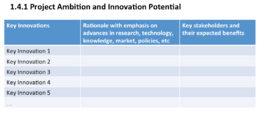1. EXCELLENCE
0. Preparatory Steps
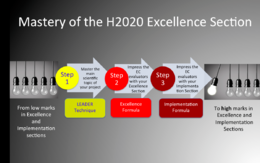
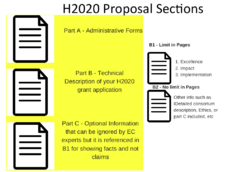
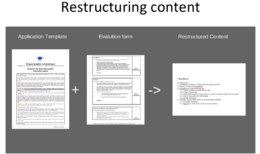
1.0 Introduction
Always begin with 2 or 2.5 PAGES with a pursued vision, i.e. a KEY industrial/economic/social SINGLE aim related to the call topic that the research and industry community has been busy with but with no significant success due to one or more key problems. Then provide scientific and statistical based evidence on why these problems are so significant and their implications in forefront knowledge/ growth/quality of life. For basing your arguments, you can use also the list of RESOURCES provided under the section RESOURCES FOR YOUR ARGUMENTS.
Apply the VPS technique (Vision – Problems - Solution)
- Vision: KEY industrial/economic/social SINGLE aim related to the call topic that the research and industry community should have been busy but they are not or have been busy with but with no significant success
- Problems:
- Reasons on why this vision is still unfulfilled
- Scientific and statistical based evidence on why these problems are significant
- Solution:
- Link your project solution with the problems above (why this solution) and also
- Summarise on the following (Why now, why in this way, why this consortium)
- N.B. Avoid words that show uncertainty (such as The PROJECT intends to, could, has the potential to …, etc)
We suggest the writing of the Introduction section in your grant application to apply the following steps:
- Step 1: Identify and use research papers/magazines/articles related to the topic of your proposal and reference them in your arguments for presenting them as facts and not as claims. Give also focus on the time factor, i.e. why now/current challenges and problems. You can apply the VPS (Vision - Problem(s) - Solution(s) approach. For example, you start with
- VISION - "For years, research community/industry has been busy with ... (e.g. Alzheimer disease and finding its cause and the cure has not been successful so far "
- PROBLEMS - Consequently, the number of people with Alzheimer is approximately 10.5 million in Europe costing currently €1.83 trillion. Furthermore, projections are alarming, i.e. by 2030 patients are expected to get to 13.4 million and to 18.7 million by 2050.
- SOLUTION - Therefore, our project has engaged some of the top researchers. medical practitioners and industry players in this area as well as the necessary infrastractures and resources (e.g. largest databases of medical data from patients with Alzheimers, MRIs, data modelling analysers and simulators, lab-tests, clinical trial expertise etc) for exploiting the current developments in curing Alzheimer disease that are still at a primitive stage and advancing them significantly via a coordinated manner so that to lead to the prevention and the cure of Alzheimer disease.
- Step 2: Now you have the attention of the evaluators and here you dig deeper. Now you need to convince them why the project’s proposed approach will be successful in contrast to the others so far. (by giving focus on "why in this way"):
- Identify and elaborate on the KEY limitations of current practices, innovations and research activities to deal with this KEY problem based on research/scientific papers/magazines/articles
- Then use words/phrases to highlight these KEY limitations (...such as attempts so far have been limited at a research lab or research center level without any actual coordination and with low achievements due to lack of or with limited access to resources that are world-widely dispersed and currenty not exploited...)
- For EACH of the KEY limitations identified above, you need to STATE that the proposed project deals with by using simple but convincing expressions. The project will ...,, our consortium will, our approach will lead to ... our project innovation will result to ...
- Step 3: Now you need to highlight the value of the proposed partnership (Why you)
- Ensure and highlight that the value chain is complete, i.e. that you have key and highly competent partners from the research, technical, users and policy areas.
- Your partnership should include direct (the ones receiving a grant) as well as indirect partners (the ones that do not receive a grant
- You need to highlight which partners fulfil specific expertise such as domain expertise, business expertise, algorithms, engineering skills, statistics, data mining, data analytics, research/ modelling, technology development/re-development, validation, testing, dissemination & Exploitation including policy influence
- You can use a VENN diagram for positioning the expertise and role of each partner. Check the example below with just four partners (P1, P2, P3 and P4) for getting the idea.
- Overall remark: You need to state expressions such as ... our consortium members have published in total more than 1200 research papers related to this domain since ... and have vast and multidisciplinary experience in interrelated domains i.e. ...
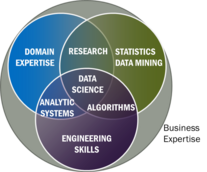
1.1 EU/Global Challenges – Project Specific Objectives (SO)
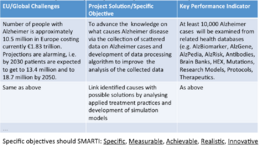
1.2 Relation to the work programme
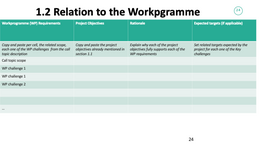
1.3 Concept and Project Methodology
This section should follow the evaluation form that the evaluator has to complete and facilitate their job but also to make them identify and not miss the essential points for making a positive evaluation. Therefore, a suggested structure is as follows:
1.3.1 Overall concept and main project idea
1.3.2 Consortium and Project Positioning
1.3.3 National/international research and innovation activities linked with the project
1.3.4 Overall approach and methodology
1.3.5 Gender Dimension
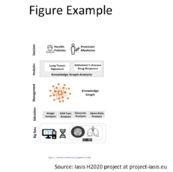
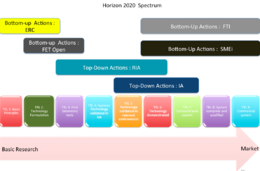
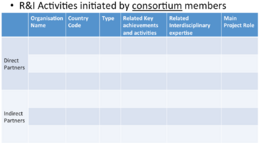


1.4 Ambition, beyond State of the Art and Innovation Potential (6-8 pages)
